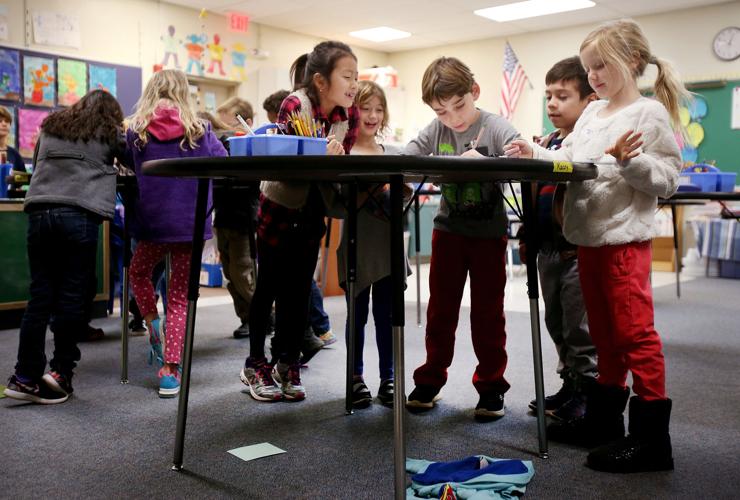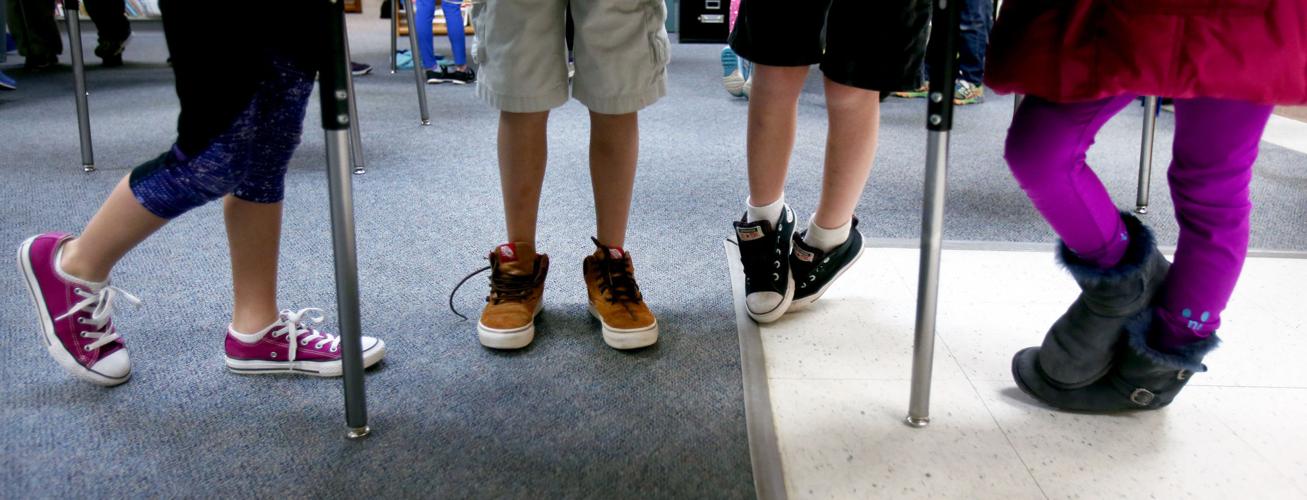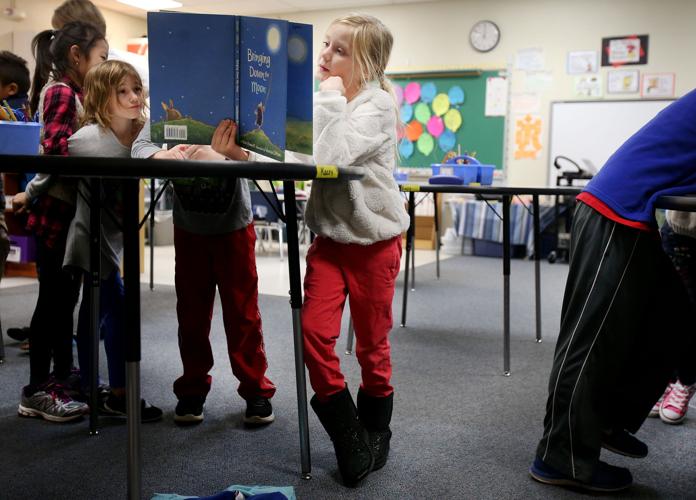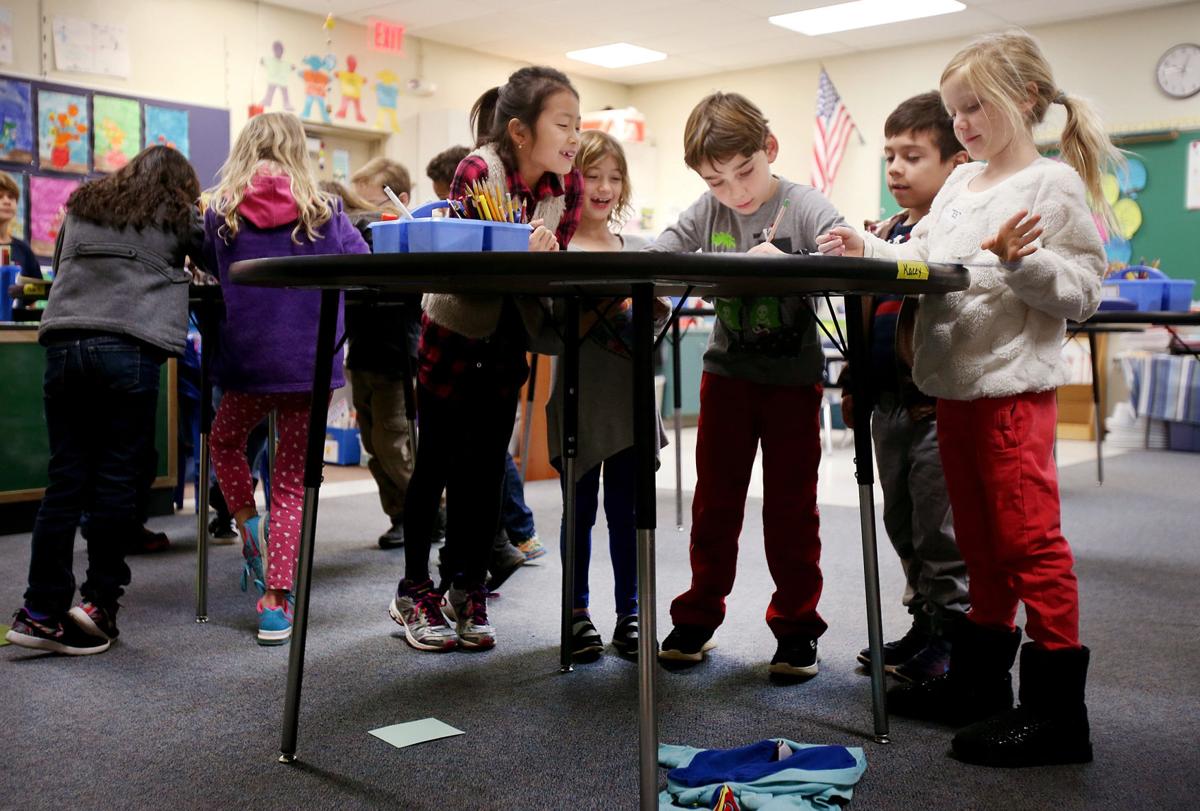When McKenzie Brown, an 8-year-old second grader, walked into her classroom after winter break, she was surprised to see that the chairs were missing from their tables.
She thought it was an oversight.
"I was like, 'Did the teacher forget to put the chairs back?'" McKenzie recalled.
But, the lack of chairs was intentional for the Manzanita Elementary School classroom, since its teacher, Tiffany Wiley, has agreed to be a tester of standing work stations.
Wiley, who teaches a first and second grade class, was approached by parent Josh Appel, an advisory board member for StandUpKids, an organization that aims to get standing desks in all U.S. classrooms, in September with the idea of converting from traditional workstations to standing ones.
After reviewing the research Appel provided, as well as doing her own, Wiley agreed to give it a try.
"The benefits are huge if you agree with the research," Wiley said. "It seemed pretty solid to me. I didn't see any negatives. There was a lot with attention — that it helps students maintain attention longer because they're not getting droopy in their seats... There were a lot of good things said, so I thought we'd give it a try."
The school's principal, Kim Boling was intrigued by the idea, too.
"The concept of flexible seating is an important one," Boling said. "I am intrigued by the benefits of standing desks and open to exploring them at our school."
Why standing
Appel is also an emergency medicine doctor at Banner University Medical Center, and says that the "growing epidemic of childhood obesity, ADHD and orthopedic issues all stem from the fact that our kids aren't moving as much."
Between sitting in class, sitting in the car or bus, sitting to do homework and eat meals, plus watching television or playing on phones or computers, children are sitting about 85 percent of their waking hours, says research done by the Kaiser Family Foundation.
In his book "Get Up! Why Your Chair is Killing You and What You Can Do About It," Dr. James Levine of the Mayo Clinic says the problem is so bad that sitting is equated with smoking because prolonged sitting will shorten your life, just like smoking.
"It's amazing the impact sitting has," Appel said. "We all do it too much. New studies have come out and are really starting to show the detriments of sitting...Even if you're involved in sports. People say 'Oh my kid plays soccer.' That's great, but it's only one hour a day and doesn't overcome the seven or eight hours they spend sitting, so it's really important that everybody keeps moving."
Standing burns 15 to 25 percent more calories than sitting does, Appel said. And, it helps the children stay focused.
"It allows kids to kind of move around and to burn off some of that energy that kids have," Appel said. "It keeps you focused and more attentive. It's hard to fall asleep when you're standing."

Students in Tiffany Wiley's multi-grade elementary class utilize standing desks to work on reading comprehension group projects at Manzanita Elementary School. The school is experimenting with the idea of standing desks.
Converting the classroom
There were concerns about how much it would cost to convert Wiley's class into a standing classroom.
But, Appel was able to modify the tables that were already there for about $40 and a day and a half of labor.
He created new legs to extend the heights of the tables.
Students are grouped together by height, so they can comfortably rest their forearms flat on the table.
"We measured all of the kids," Wiley said. "We have four different levels. They're grouped by height, which is not usually how you group students, but it works okay."
The adjoined classroom kept its regular sitting desks for now so the students could compare since they spend time in both rooms.
How's it going?
Wiley told the kids there would be some changes in the classroom when they got back from winter break, but they didn't know exactly what those changes would be.
So, the first day back was a surprise.
"When they got back, I gave them five minutes of freak out time. I said, 'come in, explore, freak out, go crazy.'" Wiley recalled. "Then we sat down (on the floor) and kind of talked about the whys, what the purpose was and then they were like hmmm.'"
There was a little grumbling from a few kids who didn't want to stand all day, so Wiley gave them options for when they were tired.
"We talked about options, about what they could do if they were tired and to respect their body. If you're tired, you should sit down," Wiley said.
There is one table with chairs around it so the students can take a sit break if they need to, or they can sit on the floor in front of the white board or at their work space.
Wiley had the students fill out a survey on the first day and was surprised at their responses.
"Because I don't want them to do something they hate," she said. "There were only six kiddos out of the 24 that were there that day that were either lukewarm or did not like. All others were super positive, which I was surprised for the first day."
Most students were not exhausted from standing all day. And, many of them actually like it.

Eva O'Brien, 7, stands at her desk to read from a book while students in Tiffany Wiley's multi-grade elementary class work on reading comprehension group projects at Manzanita Elementary School.
"I kind of like it because it helps me get a little more exercise," said Sawyer Lazarus, an 8-year-old second grader. "It keeps me more awake in class. And it's easier to move around because there are no chairs in the way."
Another student, Elias Guerrero, 7, said he likes the exercise part too.
"I like that you stand up because it gives you like a workout and it's good for your body," Elias, a first grade student, said.
Although, his legs get a little tired, Mason Hashin, an eight year old second grader, said it helps him stay awake in class.
"Their legs are tired, but not the 'I need to go to bed tired' which we have heard quite often," Wiley said. "Whether it's cause and effect, I don't know, but it's kinda cool. Their ability to fidget. They're still little. The chair is almost like a mini prison and a lot of them just can't sit still that long, so we had to build in a lot of wriggle breaks. Now we don't do that, we do sit breaks. We'll say 'you've been standing for a long time, let's sit down now.'"
Parents of Wiley's students have been positive about the change as well.
"The parents I've heard from — I've probably heard from ten out of 25 — have been overwhelmingly positive," Wiley said. "I had one tell me that her son is asking for one at home."
Wiley will continue to survey her students to decide whether to keep the standing workstations or not.
If after a month they say it's "the worst thing ever" Wiley said she probably won't keep them, but might try again next year.
However, if the response is "overwhelmingly positive", she says she will keep them.
Other schools are trying it too
Marana Unified School District is in its second year of a three-year implementation to provide students and teachers with new technology and furniture, which includes standing desks.
The district identified that students have varied preferences related to whether they sit or stand during class and is trying to honor them.
"When using standing desks, students have stated that their ability to focus and concentrate increases and that they are more comfortable than sitting," said Tamara Crawley, district spokesperson/director of public relations. "We have also had students tell us that the standing desks are like a cafe environment which is more comfortable. In addition, many of our taller students feel the standing tables are more comfortable because they are not as comfortable sitting for periods of time."
Making a difference
Getting the standing tables implemented in early grades was intentional and personal for Appel.
His daughter, Lexi, is a first grader in Wiley's class. She came home one day and told her dad she loved school so much, but didn't like how much sitting they did.
"So I got involved and fortunately Tiffany was very receptive to the idea," Appel said. "She's a very forward thinker and open to ideas, so it didn't take much convincing to try it and see how the kids respond to it."
Now, he's on a mission to get all Arizona schools converted to standing work stations.
"It's not often I feel I really have an impact on people's lives," Appel said. "I feel like this really is an opportunity to have lifelong impact, which is awesome."







